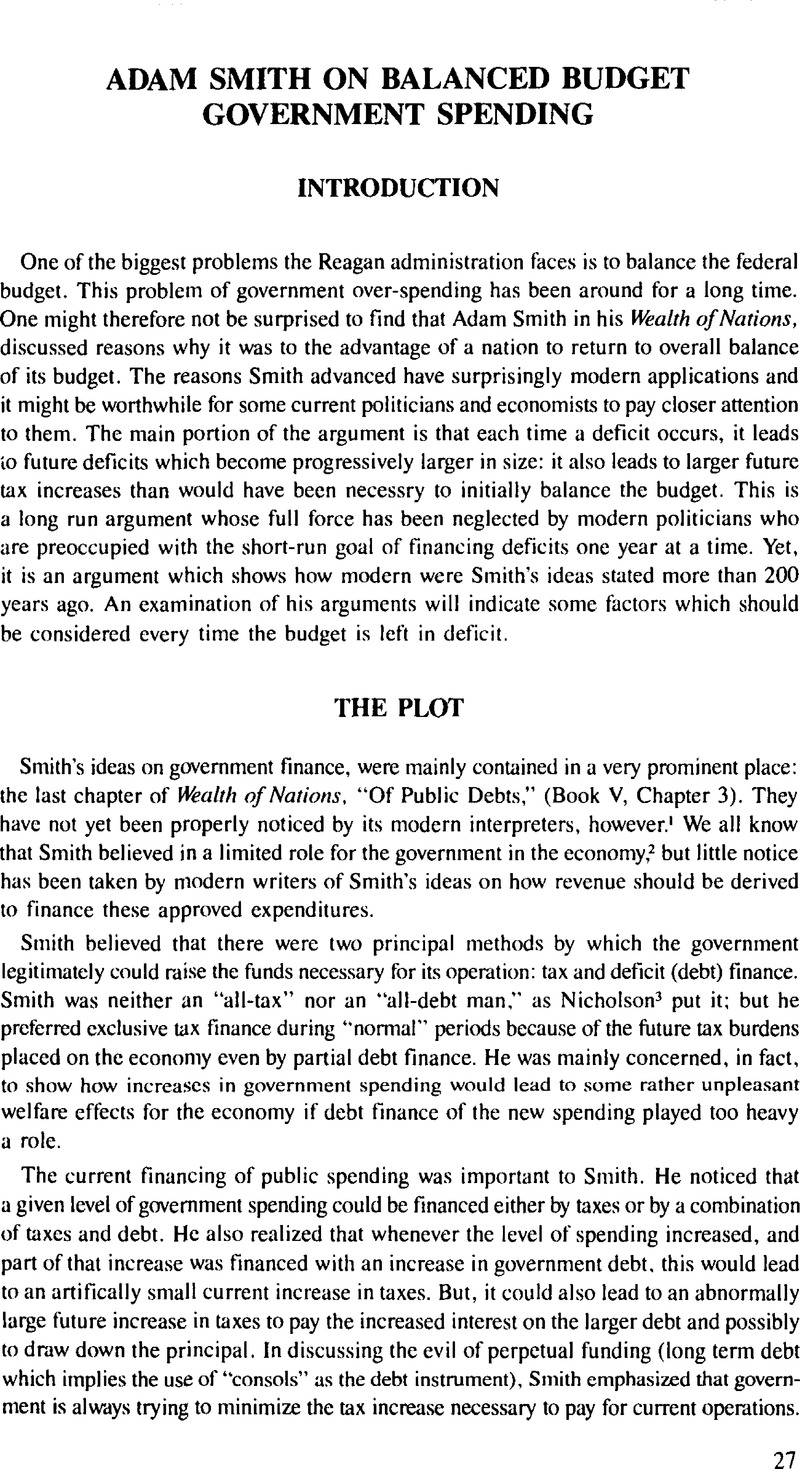No CrossRef data available.
Article contents
Adam Smith on Balanced Budget Government Spending
Published online by Cambridge University Press: 11 June 2009
Abstract

- Type
- Contributed Papers
- Information
- Copyright
- Copyright © Cambridge University Press 1987
References
FOOTNOTES
1 We refer throughout this article to the Modern Library edition of Wealth, edited by Edwin, Cannan; N.Y., Random House, 1937 (1 volume). Book V, Chapter 3, “Of Public Debts,” 859–900.Google Scholar
Two articles appeared in British journals in the 1920's which discussed Smith's ideas on government finance: 1. Nicholson, J.S., “Adam Smith on Public Debts,” The Economic Journal, 30: (1–12), 03 1920CrossRefGoogle Scholar; 2. Edwin, Cannan, “Adam Smith on Twentieth Century Finance,” Economica (First Series), 3: (93–97), 06 1923, which appeared on the 200th anniversary of the birth of Adam Smith. The Nicholson article is the much more enlightening of the two. It is surprising to note that the last 100 years of economic writings have yielded no more than these two articles which emphasized the Wealth's last chapter. Yet, contained within this chapter, we will observe many interesting ideas on the application of tax and deficit policies to raising the revenue required by the British government for its current expenditures. We will especially observe how Smith described the income redistribution effect of both these policies.Google Scholar
2 See, Viner, J., “Adam Smith on Laissez Faire,” J.P.E., 35: (198–235), 04, 1927.CrossRefGoogle Scholar
3 Nicholson, Op. Cit., p. 6 and p. 4, respectively.
“…[Smith] shows the intimate connection of public debt and taxation. Every increase of public debt means, some time or other, an increase of taxation or a lessening of the revenue available for other services.” (p. 4)
4 Smith believed that the government could borrow using short or long term obligations. Short term government borrowing was called “the method of anticipation” and long term borrowing, the method of “perpetual funding.” The latter term, simply called “funding,” was emphasized in Wealth, Book V, Chapter III. See Nicholson, p. 3. We will dispense with this dichotomy between long and short term finance in the current paper; we will, in fact, use the term “funding” throughout.
5 Taxes were assumed eventually to rise to help pay for the increased bond interest payments on the “funded” debt.
“When funding, besides, has made a certain progress, the multiplication of taxes which it brings along with it sometimes impairs … the ability of private people to accumulate …” (Wealth, p. 879.)
6 The quote from Wealth, p. 880, just given implicitly assumed that the “creditors of the public” are not the “owners of those two great sources of revenue, land and capital stock.” The impression one gets from this quote is therefore that only private financial firms are these creditors. Smith points out (p. 864) that the bank of England acts as an investment banker for the government and creates a primary market for the circulation of its debt issues. Presumably, the central bank and local banks (or country banks) would keep some government securities during the income period as part of their investment portfolios, not selling them to the non-bank piblic. It is in this sense that financial intermediaries are creditors of the government. However, at the time of Smith's writings, the private sector contained another important lender which was part of the service sector like financial firms, but which used considerable portions of capital stock concentrations (along with labor) to conduct its operations. This was the merchant class. This class of private business seems to have been regarded by Smith as a hybrid; partly similar to a pure production firm and partly similar to a pure financial firm. Smith points out (Wealth, p. 862) and (p. 871: “…the merchants are generally the people who advance money to government.”) This statement is somewhat contradictory to the analysis on p. 864 which illustrates the importance of the role of the banking sector in marketing government debt.




